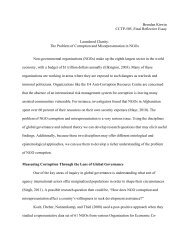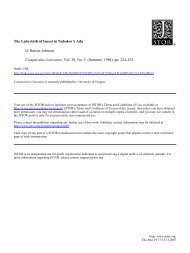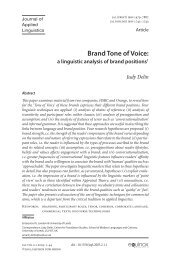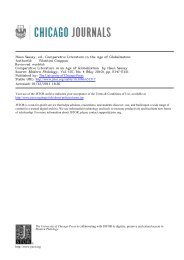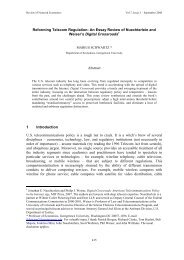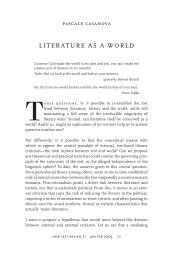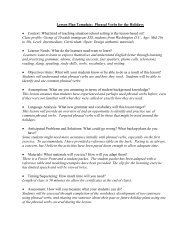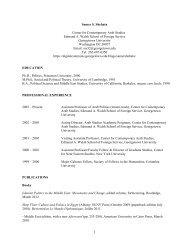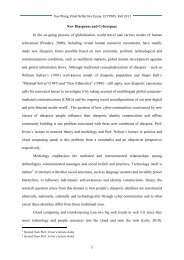roote-prokop-2013-g3-drosophila-genetics-training-all
roote-prokop-2013-g3-drosophila-genetics-training-all
roote-prokop-2013-g3-drosophila-genetics-training-all
You also want an ePaper? Increase the reach of your titles
YUMPU automatically turns print PDFs into web optimized ePapers that Google loves.
Figure 1 Simple and easy-tograsp<br />
schematics illustrating<br />
common Drosophila marker<br />
mutations. All images were<br />
generated with the “Genotype<br />
Builder” Photoshop file (File<br />
S5). (A) The default set of flies<br />
(bristle, wing and eye markers<br />
set to “wildtype”) displays<br />
wild-type body color (left column),<br />
ebony (middle column), and yellow<br />
(right column) and normal eye<br />
color (top row), white mutant eyes<br />
(middle row), and orange eyes<br />
(mini-white or w apricot ) (bottom<br />
row). (B) Example (top row only)<br />
with the settings “male” (fused<br />
abdominal stripe, sex combs,<br />
male anal plate), BRISTLES-Sb-<br />
Hu (Stubble 1/2 , short blunt<br />
bristles; Humeral 1/2 , multiplied<br />
humeral bristles), “EYE-wt”<br />
(normal shaped eyes) combined<br />
with OTHER-ry (rosy 2/2 ,<br />
brown eyes), “OTHER-Antp”<br />
(Antennapedia +/2 ; antenna-toleg<br />
transformation typical of<br />
the Antp 73b mutation), “WINGS-<br />
Cy-Ser” (Curly +/2 , curly wing;<br />
Ser +/2 , notched wing tips). (C)<br />
Example (top row only) with<br />
the settings “female” (nonfused<br />
abdominal stripes, little protrusions<br />
of anal plates), EYES-Dr<br />
(Drop +/2 , severely reduced eyes),<br />
“BRISTLES-sn” (singed 2/2 ; curled<br />
bristles) and WINGS-vg (vestigial<br />
2/2 ; severely reduced wings).<br />
Importantly, trainees are not left alone in this process, but strongly<br />
encouraged to come forward with concrete questions when problems<br />
arise. The questions asked by the trainees provide valuable<br />
insights for the teacher/trainer to pinpoint the individual gaps in<br />
understanding and correct for these through discussion and reiteration<br />
of learned material in a personalized manner.<br />
DISCUSSION<br />
The <strong>training</strong> package we have introduced here attempts to present, in<br />
a logical sequence, the aspects of Drosophila <strong>genetics</strong> that are essential<br />
for a newcomer to fly research. It does not attempt to go beyond the<br />
level that a new fly pusher would reach in due course. However, this<br />
package is designed to speed the learning process and ensure that<br />
there are no gaps in the students’ basic knowledge and understanding.<br />
The aim is to overcome initial problems by efficiently providing <strong>training</strong><br />
on key aspects of classical and modern fly <strong>genetics</strong> at the very<br />
beginning of a candidate’s fly <strong>training</strong>. The package combines different<br />
didactic strategies to meet individual needs and helps to consolidate<br />
the learned information. As an essential benefit, it takes a huge<br />
burden off the trainer’s shoulders because essential parts are based on<br />
self-study. Furthermore, through the genetic task exercise it provides<br />
an effective and objective means to assess the <strong>training</strong> success and<br />
individualize <strong>training</strong> where required.<br />
We have taken care that the <strong>training</strong> package raises awareness of<br />
important resources including FlyBase, stock centers, advanced<br />
literature, and other online aids. For example, by providing various<br />
links to FlyBase or Bloomington from different sections of the<br />
introductory manual, the <strong>training</strong> package familiarizes the student<br />
with valuable online resources and illustrates how to use them. As<br />
another example, the <strong>training</strong> package takes care to introduce trainees<br />
to historical roots and the importance of Drosophila, againpointing<br />
out helpful references. We believe it is important to understand how<br />
Drosophila’s successful use as a “boundary object” that can bridge the<br />
gap between <strong>genetics</strong> (as a tool) and other biological disciplines (as the<br />
task) (Keller 1996), has helped in the past to unravel fundamental<br />
principles of complex phenomena such as development (Lawrence<br />
1992), signaling pathways (Cadigan and Peifer 2009), cell-cycle regulation<br />
(Lee and Orr-Weaver 2003), or nervous system functions<br />
(Bellen et al. 2010; Weiner 1999). Given the speed at which diseaserelevant<br />
human genes are currently being discovered, the demand for<br />
356 | J. Roote and A. Prokop



